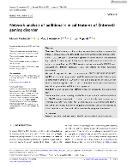Network analysis of additional clinical features of (Internet) gaming disorder

Publication date
2024Published in
International Journal of Methods in Psychiatric ResearchVolume / Issue
33 (2)ISBN / ISSN
ISSN: 1049-8931ISBN / ISSN
eISSN: 1557-0657Metadata
Show full item recordCollections
This publication has a published version with DOI 10.1002/mpr.2021
Abstract
ObjectivesThere are dozens of screening instruments purporting to measure the (Internet) gaming disorder (IGD/GD). The two prominent diagnostic manuals, DSM-5 and ICD-11, list several additional diagnostic or clinical features and problems (e.g., neglect of sleep, neglect of daily duties, health deterioration) that should co-occur or be caused by the IGD/GD. It remains unclear how specific IGD/GD operationalizations (different screening scales) are related to these functional impairments.MethodsTo explore this, data on six measures of IGD/GD (IGDS9-SF, GDSS, GDT, GAMES test, two self-assessments) and 18 additional diagnostic features were collected from a sample of 1009 players who play digital games at least 13 h per week. A network approach was utilized to determine which operationalization is most strongly associated with functional impairment.ResultsIn most of the networks, IGD/GD consistently emerged as the most central node.ConclusionThe similar centrality of IGD/GD, irrespective of its definition (DSM-5 or ICD-11) or operationalization, provides support for the valid comparison or synthesis of results from studies that used instruments coming from both DSM-5 and ICD-11 ontologies, but only if the goal is to evaluate IGD/GD relationships to other phenomena, not the relationships between the symptoms themselves.
Keywords
diagnostic, functional impairment, gaming disorder, network analysis, network approach,
Permanent link
https://hdl.handle.net/20.500.14178/2514License
Full text of this result is licensed under: Creative Commons Uveďte původ 4.0 International







